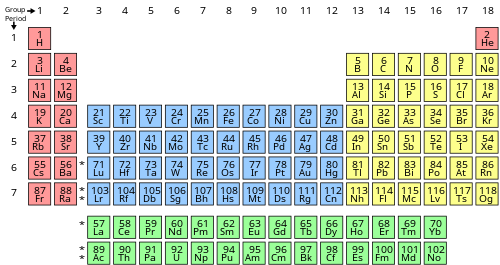
In chemistry, a group (also known as a family) [1] is a column of elements in the periodic table of the chemical elements. There are 18 numbered groups in the periodic table; the 14 f-block columns, between groups 2 and 3, are not numbered. The elements in a group have similar physical or chemical characteristics of the outermost electron shells of their atoms (i.e., the same core charge), because most chemical properties are dominated by the orbital location of the outermost electron.
Contents
- Group names
- List of group names
- CAS and old IUPAC numbering (A/B)
- Non-columnwise groups
- References
- Further reading
The modern numbering system of "group 1" to "group 18" has been recommended by the International Union of Pure and Applied Chemistry (IUPAC) since 1988.[ citation needed ] The 1-18 system is based on each atom's s, p and d electrons beyond those in atoms of the preceding noble gas. Two older incompatible naming schemes can assign the same number to different groups depending on the system being used. The older schemes were used by the Chemical Abstract Service (CAS, more popular in the United States), and by IUPAC before 1988 (more popular in Europe). The system of eighteen groups is generally accepted by the chemistry community, but some dissent exists about membership of elements number 1 and 2 (hydrogen and helium). Similar variation on the inner transition metals continues to exist in textbooks, although the correct positioning has been known since 1948 and was twice endorsed by IUPAC in 1988 (together with the 1–18 numbering) and 2021.
Groups may also be identified using their topmost element, or have a specific name. For example, group 16 is also described as the "oxygen group" and as the "chalcogens". An exception is the "iron group", which usually refers to group 8, but in chemistry may also mean iron, cobalt, and nickel, or some other set of elements with similar chemical properties. In astrophysics and nuclear physics, it usually refers to iron, cobalt, nickel, chromium, and manganese.